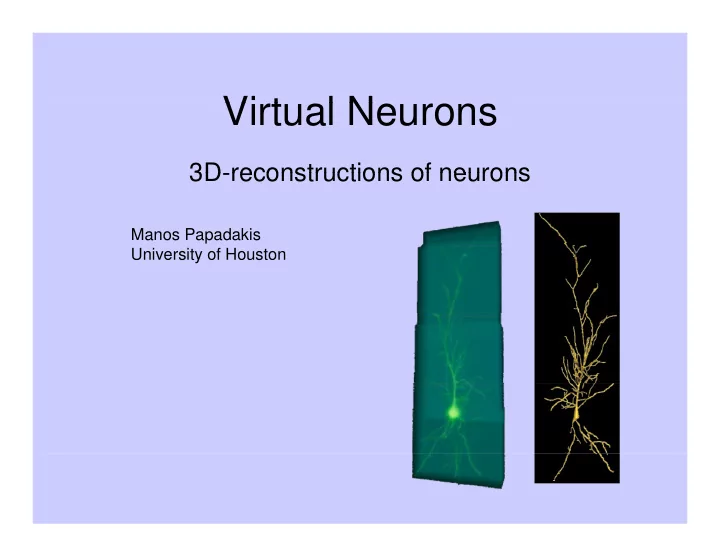

Vi t Virtual Neurons l N 3D reconstructions of neurons 3D-reconstructions of neurons Manos Papadakis p University of Houston
Collaborators I. Kakadiaris, I. Kakadiaris, D. Labate Neuroscience/data acquisition collaborators: q P. Saggau (BCM) and F. Laenza (UTMB) D. Jimenez, P. Hernadez-Herrera and A. Santamaria-Pang
Morphological reconstruction of neurons: significance i ifi • To understand the I/O relationship of individual central p neurons – Combining detailed structural and functional information Signal In Signal Out Structure and Function 3
Image Analysis Goal: Image Analysis Goal: • Extract the geometric properties of dendritic arbors g p p • Reconstruct a computer-generated 3D-image of the arbor. Do the last task when a neuron is activated and responds. This will help add a layer of a true This will help add a layer of a true activation/response model. Reconstruction 4 Raw Data
Characteristics of the dendritic structure – Global features (e.g., branch size, shape, and tapering; branch bifurcations; overall geometry, distribution of the shape of ; g y, p spines) – Local features (e.g., the dendritic spines) 5
Challenges (1) Challenges (1) • Uneven distribution of the fluorescent dye. • Depth-dependent intensity changes and scattering D th d d t i t it h d tt i 30 m 5 m 10 m x –y maximum intensity projection i i t it j ti y –z maximum intensity projection 6
Challenges (2) Challenges (2) • Irregular shape of the dendrites g p • Adjoining structures: spines • Many features of interest are at the resolution limit of light microscopy Tubular-like 2 m 2 m 2 m 2 7
Challenges (3) Challenges (3) • Low signal to noise ratio: thermal noise, photon shot g , p noise • Different noise model (Poisson) from CT or MRI • Different noise model (Poisson) from CT or MRI (Gaussian) 8
ORION 1 Morphological Reconstruction Pipeline Pi li Input: Raw data Step 2. Denoising p g Step 1. Deconvolution Step eco o ut o Step 3 Dendrite Detection Step 3. Dendrite Detection Experimental PSF 3D Frame-Based Shape learning and Denoising shape prediction Shape Model Shape Model Step 5. Morphological Step 4. Registration Output: Simulation of Step 6. Statistical Reconstruction Computational Model analysis Multiple image Medial axis and stacks registration stacks registration radius estimation Hoc file generation 9
Dendrite Detection: Shape Features • Filter the 3D-image I with Gaussian kernels G σ for different σ σ . • Extract the Hessian of I* G σ ( x ) • Find the eigenvalues of I* G σ Find the eigenvalues of I* G ( x ). These are the shape features. These are the shape features. 5 m • Classification of voxels according to the learned features . 10
Dendrite Detection: Learning from Examples Shape p Learning Data to predict Model to Learn Prediction 11
Dendrite Detection: Comparisons Orion 1 Orion 1 Original Data Original Data Frangi Sato 12
13 Results (2) Results (2) Medium Poor
14 Results (3) Results (3)
Orion 1 Reconstruction for Diadem Data Set 1 O i 1 R t ti f Di d D t S t 1 Volume 2: CF2 Volume 1: CF1
Orion 1 Reconstruction for Diadem Data Set 5 Orion 1 Reconstruction for Diadem Data Set 5 Volume 3: OP3 Volume 1: OP1
Orion 1 Reconstruction for Diadem Data Set 2 Orion 1 Reconstruction for Diadem Data Set 2 Raw data Raw data Prediction Prediction
Synthetic data volumes • Synthetic data volumes can be used for benchmarking imaging algorithms in neuroscience. • These algorithms aim to extract the geometric characteristics of a neuron from the input 3D-image. • Benchmarking of their performance must be done under • Benchmarking of their performance must be done under ideal conditions where the ground truth is precisely known. • Neurons can be modeled as tubular structures.
or or
•Is it true that if Φ α is radial then a greedy algorithm selection of Λ for f is not influenced by the rotations of f ? • What happens with other orthogonal transform groups and other norms, e.g. Sobolev norms? S b l ?
Changing resolution/superesolution resolution/superesolution Changing resolution in images or creating crisp images from a series of low-resolution images is significant in from a series of low resolution images is significant in forensic science and biometrics. Artifacts/errors must not depend on the orientation of singularities singularities.
Isotropic Re-sampling We wish to take a super-resolution or a sub-resolution using the IMRA framework. – This is meant to preserve information in an isotropic Thi i t t i f ti i i t i fashion, i.e., without directional bias. – Preliminary results show promise for optimal Preliminary results show promise for optimal performance, particularly for super-resolution, using an IMRA setting. 400 x 400 800 x 800
Isotropic Down-sampling Isotropic Down sampling • Down-sampling in an IMRA framework for Down sampling in an IMRA framework for 15 degree rotation of a line e.g.,
Isotropic Down-sampling Isotropic Down sampling • Down-sampling in an IMRA framework for Down sampling in an IMRA framework for 45 degree rotation of a line e.g.,
Isotropic Up-sampling Isotropic Up sampling • Up-sampling in an IMRA framework for 15 Up sampling in an IMRA framework for 15 degree rotation of a line e.g.,
Isotropic Up-sampling Isotropic Up sampling • Up-sampling in an IMRA framework for 45 Up sampling in an IMRA framework for 45 degree rotation of a line e.g.,
Examples of synthetic dendrites Cylinder along the x-axis for sanity check Second downsampling Second downsampling Third downsampling Third downsampling
Examples of synthetic dendrites Cross section 30 ⁰ Cross section 45 ⁰ Cross section 90 ⁰ • • • Cross section 30 ⁰ Cross section 45 ⁰ Cross section 90 ⁰ • • •
Examples of synthetic dendrites • Slices at 30 ⁰ , 45 ⁰ , and 90 ⁰
Examples of synthetic dendrites
Thank you for attending I thank the organizers for this wonderful meeting. Thank the weather for the NFFFT 2011 NFFFT 2011
Recommend
More recommend